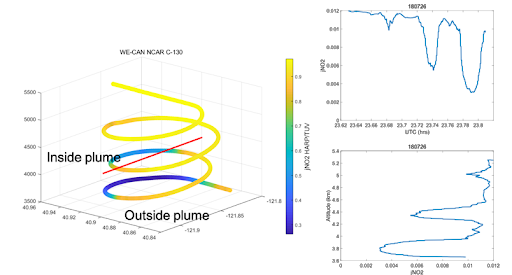First results from the Western Wildfire Experiment for Cloud Chemistry, Aerosol Absorption and Nitrogen (WE-CAN) field campaign
Western wildfire smoke has a significant impact on air quality, nutrient cycles, weather and climate. The chemistry inside a smoke plume during the first 24 hours after emission affects reactive nitrogen partitioning, cloud chemistry and nucleation, and aerosol scattering and absorption, all of which can impact air quality and climate. WE-CAN, led by CSU, deployed a large suite of measurement instruments run by both university and NCAR teams on the NSF/NCAR C-130. During the 16 research flights based out of Boise, 21 different wildfire plumes were sampled, representing different fuel mixes and different burning stages of typical forest fires in the western US. Fire plume data analysis is still in progress, but some key preliminary findings have emerged.
The ozone production efficiency in the fire plumes are strongly dependent on the initial amounts of NOx and HONO present, which is a function of the temperature and intensity of the fire. For example, the Taylor Creek fire in south-central Oregon is compared to the Bear Trap Fire in eastern Utah in Figure 1. With mostly comparable VOC concentrations in the plume, the Taylor Creek fire plume contained am order of magnitude more NOx and almost 30 times more HONO, resulting in a much higher production of ozone.
At the same time, chemistry in a dense fire plume can be different at the top of the plume versus the darker bottom of the same plume. Figure 2 demonstrates this in an altitude profile flown inside the Carr Fire outflow, where the photolysis frequency for NO2 at the bottom of the plume was only about one third of the value at the top. This has profound effects on the ozone and aerosol production chemistry across the vertical extent of the plume.

Contact
Please direct questions/comments about this page to:
Carl Drews
NSF NCAR | Research IT | ACOM
